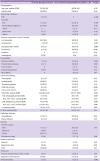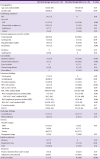1. Catherinot E, Lanternier F, Bougnoux ME, Lecuit M, Couderc LJ, Lortholary O. Pneumocystis jirovecii pneumonia. Infect Dis Clin North Am. 2010; 24:107–138.
2. Fillatre P, Decaux O, Jouneau S, Revest M, Gacouin A, Robert-Gangneux F, Fresnel A, Guiguen C, Le Tulzo Y, Jégo P, Tattevin P.. Incidence of Pneumocystis jiroveci pneumonia among groups at risk in HIV-negative patients. Am J Med. 2014; 127:1242.e11–1242.e17.
3. Smego RA Jr, Nagar S, Maloba B, Popara M. A meta-analysis of salvage therapy for pneumocystis carinii pneumonia. Arch Intern Med. 2001; 161:1529–1533.

4. Kim T, Moon SM, Sung H, Kim MN, Kim SH, Choi SH, Jeong JY, Woo JH, Kim YS, Lee SO. Outcomes of non-HIV-infected patients with Pneumocystis pneumonia and concomitant pulmonary cytomegalovirus infection. Scand J Infect Dis. 2012; 44:670–677.

5. Roblot F, Godet C, Le Moal G, Garo B, Faouzi Souala M, Dary M, De Gentile L, Gandji JA, Guimard Y, Lacroix C, Roblot P, Becq-Giraudon B. Analysis of underlying diseases and prognosis factors associated with Pneumocystis carinii pneumonia in immunocompromised HIV-negative patients. Eur J Clin Microbiol Infect Dis. 2002; 21:523–531.
6. Allegra CJ, Chabner BA, Tuazon CU, Ogata-Arakaki D, Baird B, Drake JC, Simmons JT, Lack EE, Shelhamer JH, Balis F, Walker R, Kovacs JA, Clifford Lane H, Masur H. Trimetrexate for the treatment of Pneumocystis carinii pneumonia in patients with the acquired immunodeficiency syndrome. N Engl J Med. 1987; 317:978–985.

7. Walzer PD, Smulian G, Miller RF. Pneumocystis species. In : Bennet JE, Dolin R, Blaser MJ, editors. Priniciples and practice of infectious diseases. Philadelpia, PA: Elsevier;2015. p. 3016–3030.
8. Deresinski SC, Stevens DA. Caspofungin. Clin Infect Dis. 2003; 36:1445–1457.

9. Kim T, Hong HL, Lee YM, Sung H, Kim SH, Choi SH, Kim YS, Woo JH, Lee SO. Is caspofungin really an effective treatment for Pneumocystis jirovecii pneumonia in immunocompromised patients without human immunodeficiency virus infection? Experiences at a single center and a literature review. Scand J Infect Dis. 2013; 45:484–488.

10. Mitsides N, Greenan K, Green D, Middleton R, Lamerton E, Allen J, Redshaw J, Chadwick PR, Subudhi CP, Wood G. Complications and outcomes of trimethoprim-sulphamethoxazole as chemoprophylaxis for pneumocystis pneumonia in renal transplant recipients. Nephrology (Carlton). 2014; 19:157–163.

11. Kim T, Kim SH, Park KH, Cho OH, Sung H, Kim MN, Choi SH, Jeong JY, Woo JH, Kim YS, Lee SO. Clindamycin-primaquine versus pentamidine for the second-line treatment of pneumocystis pneumonia. J Infect Chemother. 2009; 15:343–346.

12. Choi SH, Hong SB, Ko GB, Lee Y, Park HJ, Park SY, Moon SM, Cho OH, Park KH, Chong YP, Kim SH, Huh JW, Sung H, Do KH, Lee SO, Kim MN, Jeong JY, Lim CM, Kim YS, Woo JH, Koh Y. Viral infection in patients with severe pneumonia requiring intensive care unit admission. Am J Respir Crit Care Med. 2012; 186:325–332.

13. Horan TC, Andrus M, Dudeck MA. CDC/NHSN surveillance definition of health care-associated infection and criteria for specific types of infections in the acute care setting. Am J Infect Control. 2008; 36:309–332.

14. Lee JY, Park HJ, Kim YK, Yu S, Chong YP, Kim SH, Sung H, Lee SO, Kim MN, Lim CM, Kim YS, Koh Y, Woo JH, Choi SH. Cellular profiles of bronchoalveolar lavage fluid and their prognostic significance for non-HIV-infected patients with
Pneumocystis jirovecii pneumonia. J Clin Microbiol. 2015; 53:1310–1316.

15. Fauchier T, Hasseine L, Gari-Toussaint M, Casanova V, Marty PM, Pomares C. Detection of
Pneumocystis jirovecii by quantitative PCR to differentiate colonization and pneumonia in immunocompromised HIV-positive and HIV-negative patients. J Clin Microbiol. 2016; 54:1487–1495.

16. Pfaller MA, Anaissie EJ. Pneumocystis. In : Anaissie EJ, McGinnis MR, Pfaller MA, editors. Clinical Mycology. Oxford, UK: Churchill Livingstone;2009. p. 385–401.
17. Moon SM, Kim T, Sung H, Kim MN, Kim SH, Choi SH, Jeong JY, Woo JH, Kim YS, Lee SO. Outcomes of moderate-to-severe
Pneumocystis pneumonia treated with adjunctive steroid in non-HIV-infected patients. Antimicrob Agents Chemother. 2011; 55:4613–4618.

18. Edwards IR, Aronson JK. Adverse drug reactions: definitions, diagnosis, and management. Lancet. 2000; 356:1255–1259.

19. Jensen BN, Lisse IM, Gerstoft J, Borgeskov S, Skinhøj P. Cellular profiles in bronchoalveolar lavage fluid of HIV-infected patients with pulmonary symptoms: relation to diagnosis and prognosis. AIDS. 1991; 5:527–533.

20. Benfield TL, Kharazmi A, Larsen CG, Lundgren JD. Neutrophil chemotactic activity in bronchoalveolar lavage fluid of patients with aids-associated
Pneumocystis carinii pneumonia. Scand J Infect Dis. 1997; 29:367–371.

21. Duong T, Jourdain G, Ngo-Giang-Huong N, Le Cœur S, Kantipong P, Buranabanjasatean S, Leenasirimakul P, Ariyadej S, Tansuphasawasdikul S, Thongpaen S, Lallemant M; Program for HIV Prevention and Treatment Study Group. Laboratory and clinical predictors of disease progression following initiation of combination therapy in hiv-infected adults in Thailand. PLoS One. 2012; 7:e43375.

22. Struijk GH, Gijsen AF, Yong SL, Zwinderman AH, Geerlings SE, Lettinga KD, van Donselaar-van der Pant KA, ten Berge IJ, Bemelman FJ. Risk of
Pneumocystis jiroveci pneumonia in patients long after renal transplantation. Nephrol Dial Transplant. 2011; 26:3391–3398.

23. Hashimoto K, Kobayashi Y, Asakura Y, Mori M, Azuma T, Maruyama D, Kim SW, Watanabe T, Tobinai K.
Pneumocystis jiroveci pneumonia in relation to cd4+ lymphocyte count in patients with b-cell non-hodgkin lymphoma treated with chemotherapy. Leuk Lymphoma. 2010; 51:1816–1821.

24. Fei MW, Kim EJ, Sant CA, Jarlsberg LG, Davis JL, Swartzman A, Huang L. Predicting mortality from HIV-associated
Pneumocystis pneumonia at illness presentation: an observational cohort study. Thorax. 2009; 64:1070–1076.

25. Shahrin L, Leung DT, Matin N, Pervez MM, Azim T, Bardhan PK, Heffelfinger JD, Chisti MJ. Characteristics and predictors of death among hospitalized HIV-infected patients in a low HIV prevalence country: Bangladesh. PLoS One. 2014; 9:e113095.

26. Ruf B, Rohde I, Pohle HD. Efficacy of clindamycin/primaquine versus trimethoprim/sulfamethoxazole in primary treatment of
Pneumocystis carinii pneumonia. Eur J Clin Microbiol Infect Dis. 1991; 10:207–210.

27. Toma E, Thorne A, Singer J, Raboud J, Lemieux C, Trottier S, Bergeron MG, Tsoukas C, Falutz J, Lalonde R, Gaudreau C, Therrien R. Clindamycin with primaquine vs. Trimethoprim-sulfamethoxazole therapy for mild and moderately severe pneumocystis carinii pneumonia in patients with aids: A multicenter, double-blind, randomized trial (CTN 004). CTN-PCP study group. Clin Infect Dis. 1998; 27:524–530.

28. Helweg-Larsen J, Benfield T, Atzori C, Miller RF. Clinical efficacy of first- and second-line treatments for HIV-associated
Pneumocystis jirovecii pneumonia: a tri-centre cohort study. J Antimicrob Chemother. 2009; 64:1282–1290.








 PDF
PDF ePub
ePub Citation
Citation Print
Print



 XML Download
XML Download